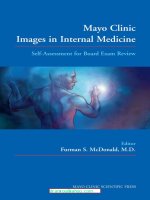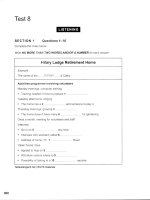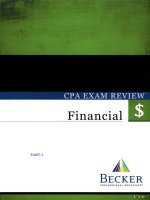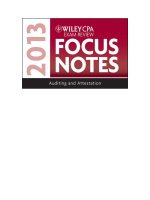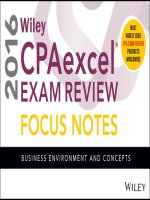- Trang chủ >>
- Y - Dược >>
- Ngoại khoa
Physician coding exam review 2014
Bạn đang xem bản rút gọn của tài liệu. Xem và tải ngay bản đầy đủ của tài liệu tại đây (28.8 MB, 691 trang )
YOU’VE JUST PURCHASED
MORE THAN
*
A TEXTBOOK!
Evolve Student Resources for Buck: Physician Coding Exam
Review 2014: The Certification Step with ICD-9-CM, include
the following:
•
Practice Certification Exams
•
Coding Updates, Tips, and Links
•
Content Updates
•
Mobile-optimized 10 question
terminology and pathology quick quizzes
Scan the QR code
to access your free
mobile content.*
Activate the complete learning experience that comes with each
NEW textbook purchase by registering with your scratch-off access code at
/>If you purchased a used book and the scratch-off code at right has
already been revealed, the code may have been used and cannot
be re-used for registration. To purchase a new code to access these
valuable study resources, simply follow the link above.
www.drmyothethan.blogspot.com
REGISTER TODAY!
You can now purchase Elsevier products on Evolve!
Go to evolve.elsevier.com/html/shop-promo.html to search and browse for products.
* Evolve Student Resources are provided free with each NEW book purchase only.
2014
PHYSICIAN CODING
EXAM REVIEW
THE CERTIFICATION STEP
with ICD-9-CM
Carol J. Buck
MS, CPC, CPC-H, CCS-P
Former Program Director
Medical Secretary Programs
Northwest Technical College
East Grand Forks, Minnesota
3251 Riverport Lane
St. Louis, Missouri 63043
PHYSICIAN CODING EXAM REVIEW 2014:
THE CERTIFICATION STEP WITH ICD-9-CM
ISBN: 978-1-4557-2287-7
Copyright © 2014, 2013, 2012, 2011, 2010, 2009, 2008, 2007, 2006, 2005, 2004 by Saunders, an
imprint of Elsevier Inc.
All rights reserved. No part of this publication may be reproduced or transmitted in any form or by any
means, electronic or mechanical, including photocopy, recording, or any information storage and retrieval
system, without permission in writing from the publisher. Details on how to seek permission, further
information about the Publisher’s permissions policies and our arrangements with organizations such as
the Copyright Clearance Center and the Copyright Licensing Agency, can be found at our website:
www.elsevier.com/permissions.
This book and the individual contributions contained in it are protected under copyright by the Publisher
(other than as may be noted herein).
NOTE: Current Procedural Terminology, 2014, was used in updating this text.
Current Procedural Terminology (CPT) is copyright 2013 American Medical Association. All rights reserved.
No fee schedules, basic units, relative values, or related listings are included in CPT. The AMA assumes no
liability for the data contained herein. Applicable FARS/DFARS restrictions apply to government use.
Notices
Knowledge and best practice in this field are constantly changing. As new research and experience
broaden our understanding, changes in research methods, professional practices, or medical treatment
may become necessary.
Practitioners and researchers must always rely on their own experience and knowledge in evaluating
and using any information, methods, compounds, or experiments described herein. In using such information or methods they should be mindful of their own safety and the safety of others, including
parties for whom they have a professional responsibility.
With respect to any drug or pharmaceutical products identified, readers are advised to check the most
current information provided (i) on procedures featured or (ii) by the manufacturer of each product to
be administered, to verify the recommended dose or formula, the method and duration of administration, and contraindications. It is the responsibility of practitioners, relying on their own experience and
knowledge of their patients, to make diagnoses, to determine dosages and the best treatment for each
individual patient, and to take all appropriate safety precautions.
To the fullest extent of the law, neither the Publisher nor the authors, contributors, or editors
assume any liability for any injury and/or damage to persons or property as a matter of products
liability, negligence or otherwise, or from any use or operation of any methods, products, instructions,
or ideas contained in the material herein.
Library of Congress Cataloging-in-Publication Data
Buck, Carol J., author.
2014 physician coding exam review : the certification step with ICD-9-CM / Carol J. Buck.
p. ; cm.
Physician coding exam review
Includes index.
Preceded by: 2013 physician coding exam review / Carol J. Buck. 2013 ed. c2013.
ISBN 978-1-4557-2287-7 (pbk. : alk. paper)
I. Title. II. Title: Physician coding exam review.
[DNLM: 1. International classification of diseases. 9th revision. Clinical modification.
2. Classification—Examination Questions. 3. Clinical Coding—methods—Examination Questions.
4. Terminology as Topic—Examination Questions. WB 18.2]
RB115
616.001′2—dc23
2013019381
Content Strategy Director: Jeanne R. Olson
Associate Content Development Specialist: Helen O’Neal
Publishing Services Manager: Pat Joiner
Senior Project Manager: Joy Moore
Senior Designer: Amy Buxton
Printed in the United States of America
Last digit is the print number: 9
8
7
6
5
4
3
2
1
Dedication
To coding instructors,
who each day strive to enhance the lives
of their students and provide the next generation
of knowledgeable medical coders.
Carol J. Buck
Acknowledgments
There are so many, many people who participated in the development of this
text, and only through the effort of all of the team members has it been possible
to publish this text.
Sheri Poe Bernard, who has assumed responsibility for development of this
text. Jackie Grass, who has contributed significantly to its content.
John W. Danaher, President, Education, and Sally Schrefer, former
Executive Vice President, Nursing/Health Sciences, who possess great listening
skills and the ability to ensure the publication of high-quality educational
materials. Andrew Allen, Vice President and Publisher, Health Professions,
who sees the bigger picture and shares the vision. Jeanne R. Olson, Content
Strategy Director, who maintains an excellent sense of humor and is a valued
member of the team who can always be depended upon for reasoned judgment.
Helen O’Neal, Associate Content Development Specialist, who assumed the
responsibility of shepherding this project to production with steady fortitude.
Amy Simpson, Production Editor at Graphic World, who assumed
responsibility for many projects while maintaining a high degree of
professionalism. The employees of Elsevier, who have participated in the
publication of this text and demonstrated exceptional professionalism and
competence. Arlene Scher, Senior Program Coordinator at Augusta State
University Division of Continuing Education, for her sharp eye and help
regarding the organization of the exam questions.
Preface
Thank you for purchasing Physician Coding Exam Review 2014: The Certification
Step with ICD-9-CM, the latest guide to the outpatient physician coding certification exam. This 2014 edition has been carefully reviewed and updated with the
latest content, making it the most current guide for your review. The author and
publishers have made every effort to equip you with skills and tools you will
need to succeed on the exam. To this end, this review guide presents essential
information about all health care coding systems, anatomy, terminology, and
pathophysiology, as well as sample examinations for practice. No other review
guide on the market brings together such thorough coverage of all necessary
examination material in one source.
ORGANIZATION OF THIS TEXTBOOK
Following a basic outline approach, Physician Coding Exam Review 2014: The
Certification Step with ICD-9-CM takes a practical approach to assisting you with
your examination preparations. The text is divided into four units—Anatomy,
Terminology, and Pathophysiology; Reimbursement Issues; Overview of CPT,
ICD-9-CM, and HCPCS Coding; and Preparing for Practice Examinations—and
there are several appendices for your reference. Additionally, examinations are
provided on the companion Evolve website to assist you in your preparation.
Some of the CPT code descriptions for physician services include physician extender services. Physician extenders, such as nurse practitioners, physician assistants, and nurse anesthetists, etc., provide medical services
typically performed by a physician. Within this educational material the term “physician” may include “and other
qualified health care professionals” depending on the code. Refer to the official CPT® code descriptions and
guidelines to determine codes that are appropriate to report services provided by non-physician practitioners.
Preface
Unit 1,
Anatomy,
Terminology,
and
Pathophysiology
Covers all the
essential body
systems and
terms you’ll need
to get certified.
Organized by
body systems to
follow the CPT
codes, the sections also include
illustrations to
review each
major anatomical
area and quizzes
to check your
understanding
and recall
(Answers are
located at the
end of Unit 1).
UNIT 1 Anatomy, Terminology, and Pathophysiology
Left common
carotid artery
Brachiocephalic
artery
Left subclavian
artery
Superior
vena cava
Arch of aorta
Pulmonary artery
Pulmonary
artery
Pulmonic vein
Right
pulmonary vein
Left atrium
Right atrium
Mitral (bicuspid)
valve
Aortic valve
Pulmonary
semilunar valve
Left ventricle
Myocardium
Tricuspid valve
Epicardium
Right ventricle
Endocardium
Inferior
vena cava
Interventricular
septum
Apex
Aorta
Figure 1-18
Internal view of heart.
UNIT 2 Reimbursement Issues
C.
MG
Unit 2,
Reimbursement
Issues
Provides a review
of important insurance and billing
information to help
you review the
connections
between medical
coding, insurance,
billing, and
reimbursement.
viii
D. PROCEDURES, SERVICES, OR SUPPLIES
(Explain Unusual Circumstances)
CPT/HCPCS
MODIFIER
26. PATIENT’S ACCOUNT NO.
E.
DIAGNOSIS
POINTER
27. ACCEPT ASSIGNMENT?
(For
govt. claims, see back)
YES
NO
32. SERVICE FACILITY LOCATION INFORMATION
a.
NPI
b.
Figure 2-1 Block 27, Accept Assignment on CMS-1500 (02/12) Health Insurance
Claim Form. (Courtesy U.S. Department of Health and Human Services, Centers for
Medicare and Medicaid Services.)
Preface
Unit 3,
Overview of
CPT, ICD-9-CM,
and HCPCS
Coding
Contains comprehensive coverage of the
different coding
systems and their
applications,
making other references unnecessary! Simplified
text and clear
examples are the
highlights of
this unit, and
illustrations are
included to
clarify difficult
concepts.
Surgery Section (10021-69990)
Cervical
vertebrae
C1
C2
C3
C4
C5
C6
C7
Cervical
curve
T1
T2
T3
T4
T5
T6
Thoracic
vertebrae
T7
Thoracic
curve
T8
T9
T10
T11
T12
L1
L2
Lumbar
vertebrae
L3
Lumbar
curve
L4
L5
Sacrum
Sacral
curve
Coccyx
(tailbone)
Figure 3-12 The spinal cord is part of the central nervous system (CNS) and extends
from the brain to the lower back.
Unit 4, Preparing
for Practice
Examinations
Contains a Final
Examination to be
taken at the end of
your complete
program of study. To
help you quantify
the examination, this
is meant to be taken
using paper and
pencil.
Final Examination
FINAL EXAMINATION
Direction: Report only the professional component unless specifically
directed to do otherwise within the question.
Subject Area: Medical Terminology
1. This term means the surgical removal of the fallopian tube:
A. ligation
B. hysterectomy
C. salpingostomy
D. salpingectomy
2. This combining form means “thirst”:
A. dips/o
B. acr/o
C. cortic/o
D. somat/o
ix
Preface
ABOUT THE PRACTICE EXAMINATIONS
The companion Evolve website contains valuable resources to assist you with
your preparation for the Physician coding certification examination. (See Additional Evolve Resources on pages xii and xiii for more information on how to
access this website.) It includes two timed and scored 150-question practice
examinations (the same examination is taken twice). The Pre-Examination on
the Evolve website should be completed at the start of your study, and the PostExamination, also on the Evolve website, should be taken after your study is
complete. By comparing the results of these examinations, you can see your
improvement after using the review guide! Once you check your scores, you are
ready to take the Final Examination in Unit 4 of the text.
Summary Screen
When using the program, the Exam Sessions screen serves as home base. Here
you can find information relating to your progress and performance in different
subject areas. From this screen, you can choose an examination mode, submit
an examination, check your progress, review your results, and access the Final
Examination scoresheet and answers.
In addition to displaying your scores for completed sections and tracking the
total elapsed time, this screen also shows the total, attempted, and correct
questions in each subsection. You can return to the Exam Sessions screen at any
point while taking or reviewing an examination, and all information related to
your answers and position is saved.
Summary screen.
Taking the Examination
While taking the examination, click on the letter of your answer choice, and the
circle will appear in red to the left. Click on the “Next” button at the bottom of
the screen to proceed to the next question. At the top of the screen, the Quick
x
Preface
Jump feature is a pull-down menu that allows you jump to any question in the
current section. Additionally, the Bookmark button at the bottom of the screen
allows you to mark questions for later reference.
Question screen.
Reviewing Your Results
Once you have taken the Post-Examination on the companion Evolve website,
you have the option to review all the Pre- and Post-Examination questions with
rationales, even the ones you answered correctly, by clicking the “Review Exam”
button at the bottom of the screen. The correct answer is shown for each question, and a rationale is given for each answer option. Or, if you prefer, you can
review the answers and rationales using a PDF answer sheet. You can also
compare your results on the Pre- and Post-Examinations by clicking on each
exam on the Exam Sessions screen and viewing your results in the “Completed
Exams” on the right or by printing out your results.
Once you have completed the Final Examination in Unit 4, you will access
the electronic score sheet on the Evolve website and enter your answers. The
software will then provide you with the answers and rationales.
xi
Preface
SUPPLEMENTAL RESOURCES
However you decide to prepare for the certification examination, we have
developed supplements designed to complement the Physician Coding Exam
Review 2014: The Certification Step with ICD-9-CM. Each of these supplements has
been developed with the needs of both students and instructors in mind.
Instructor’s Electronic Resource
No matter what your level of teaching experience, this total-teaching solution,
located on the companion Evolve website, will help you plan your lessons with
ease, and the author has developed all the curriculum materials necessary to use
the textbook in the classroom. This includes additional unit quizzes, a course
calendar and syllabus, lesson plans, ready-made tests for easy assessment, and
PDF files with the questions and answers for the Pre-/Post- and Final Examinations. Also included is a comprehensive PowerPoint collection for the entire text,
and ExamView test banks. The PowerPoint slides can be easily customized to
support your lectures or formatted as overhead transparencies or handouts for
student note-taking. The ExamView test generator will help you quickly and
easily prepare quizzes and exams from the ready-made test questions, and the
test banks can be customized to your specific teaching methods.
Additional Evolve Resources
The companion Evolve website offers many resources that will extend your
studies beyond the classroom. Related WebLinks offer you the opportunity to
expand your knowledge base and stay current with this ever-changing field,
and additional material is available for help and practice.
xii
Preface
A Course Management System (CMS) is also available free to instructors who
adopt this textbook. This web-based platform gives instructors yet another
resource to facilitate learning and to make medical coding content accessible to
students. In addition to the Evolve Resources available to both faculty and students, there is an entire suite of tools available that allows for communication
between instructors and students. Students can log on through the Evolve portal
to take online quizzes and practice examinations, participate in threaded discussions, post assignments to instructors, or chat with other classmates, while
instructors can use the online grade book to follow class progress.
To access this comprehensive online resource, follow the instructions located
on the inside front cover of this book. You will need the Course ID number provided by your instructor. If your instructor has not set up a Course Management
System, you can still access the free Evolve resources at
/>
xiii
Development of
This Edition
This book would not have been possible without a team of educators and professionals, including practicing coders and technical consultants. The combined
efforts of the team members have made this text an incredible learning tool.
SENIOR TECHNICAL COLLABORATOR
Sheri Poe Bernard, CCS-P, CPC,
CPC-H, CPC-I
Coding Education Specialist
Salt Lake City, Utah
LEAD TECHNICAL COLLABORATOR
Jacqueline Klitz Grass, MA, CPC
Coding and Reimbursement Specialist
Grand Forks, North Dakota
QUERY MANAGER
Patricia Cordy Henricksen, MS,
CHCA, CPC-I, CPC, CCP-P,
ASC-PCS
Auditing and Coding Educator
Soterion Medical Services
Lexington, Kentucky
SENIOR ICD-9-CM AND ICD-10-CM CODING SPECIALIST
Karla R. Lovaasen, RHIA, CCS,
CCS-P
Coding and Consulting Services
Abingdon, Maryland
—Coauthor of ICD-9-CM Coding:
Theory and Practice with ICD-10,
2013/2014 Edition, St. Louis, 2013,
Saunders.
—Coauthor of ICD-10-CM/PCS
Coding: Theory and Practice, 2014
Edition, St. Louis, 2014, Saunders.
SENIOR COLLABORATOR AND ICD-10-CM CONSULTANT
Nancy Maguire, ACS, CRT, PCS,
FCS, HCS-D, APC, AFC
Physician Consultant for Auditing
and Education
Winchester, Virginia
Development of This Edition
CODING SPECIALISTS
Robert H. Ekvall, PhD, CCS,
CPC-H, CPC
Coder/Biller
Scripps Green Hospital
La Jolla, California
Danielle Laitres, CPC
Stuart, Florida
Sylvia Partridge, CPC, CGSC
Coding Instructor
Athens, Georgia
Debra Kroll, RHIT
Denial and Billing Compliance
Supervisor
Altru Health System
Grand Forks, North Dakota
EDITORIAL REVIEW BOARD
Aimée Michaelis, MEd, CPC
Lead Instructor
Pima Medical Institute
Denver, Colorado
Andrea D. Potteiger, CCS,
CCS-P, CPC
Senior Coder
Edaptive Systems
York, Pennsylvania
xv
This page intentionally left blank
Contents
Success Strategies, S-1
Course Syllabus and Student Calendar, C-1
Unit 1
1
Anatomy, Terminology, and Pathophysiology, 1
Integumentary System
Integumentary
Integumentary
Integumentary
Integumentary
2
System—Anatomy and Terminology, 2
System Anatomy and Terminology Quiz, 7
System—Pathophysiology, 9
System Pathophysiology Quiz, 27
Musculoskeletal System
Musculoskeletal
Musculoskeletal
Musculoskeletal
Musculoskeletal
3
Respiratory System
Respiratory
Respiratory
Respiratory
Respiratory
4
System—Anatomy and Terminology, 55
System Anatomy and Terminology Quiz, 63
System—Pathophysiology, 65
System Pathophysiology Quiz, 71
Cardiovascular System
Cardiovascular
Cardiovascular
Cardiovascular
Cardiovascular
5
System—Anatomy and Terminology, 29
System Anatomy and Terminology Quiz, 45
System—Pathophysiology, 47
System Pathophysiology Quiz, 53
System—Anatomy and Terminology, 73
System Anatomy and Terminology Quiz, 83
System—Pathophysiology, 85
System Pathophysiology Quiz, 95
Female Genital System and Pregnancy
Female Genital System and
and Terminology, 97
Female Genital System and
Quiz, 105
Female Genital System and
Female Genital System and
6
Pregnancy—Anatomy
Pregnancy Anatomy and Terminology
Pregnancy—Pathophysiology, 107
Pregnancy Pathophysiology Quiz, 121
Male Genital System
Male Genital System—Anatomy and Terminology, 123
Male Genital System Anatomy and Terminology Quiz, 127
Contents
Male Genital System—Pathophysiology, 129
Male Genital System Pathophysiology Quiz, 139
7
Urinary System
Urinary
Urinary
Urinary
Urinary
8
System—Anatomy and Terminology, 141
System Anatomy and Terminology Quiz, 147
System—Pathophysiology, 149
System Pathophysiology Quiz, 159
Digestive System
Digestive
Digestive
Digestive
Digestive
9
System—Anatomy and Terminology, 161
System Anatomy and Terminology Quiz, 169
System—Pathophysiology, 171
System Pathophysiology Quiz, 189
Mediastinum and Diaphragm
Mediastinum and Diaphragm—Anatomy and Terminology, 191
Mediastinum and Diaphragm Anatomy and Terminology Quiz, 193
10
Hemic and Lymphatic System
Hemic
Hemic
Hemic
Hemic
11
and
and
and
and
System—Anatomy and Terminology, 211
System Anatomy and Terminology Quiz, 217
System—Pathophysiology, 219
System Pathophysiology Quiz, 227
Nervous System
Nervous
Nervous
Nervous
Nervous
13
System—Anatomy and Terminology, 195
System Anatomy and Terminology Quiz, 199
System—Pathophysiology, 201
System Pathophysiology Quiz, 209
Endocrine System
Endocrine
Endocrine
Endocrine
Endocrine
12
Lymphatic
Lymphatic
Lymphatic
Lymphatic
System—Anatomy and Terminology, 229
System Anatomy and Terminology Quiz, 235
System—Pathophysiology, 237
System Pathophysiology Quiz, 251
Senses
Senses—Anatomy and Terminology, 253
Senses Anatomy and Terminology Quiz, 261
Senses—Pathophysiology, 263
Senses Pathophysiology Quiz, 269
xviii
14
Unit 1 Quiz Answers, 271
Unit 2
Reimbursement Issues, 277
1
Reimbursement Issues, 278
2
National Correct Coding Initiative (NCCI), 282
3
Federal Register, 282
4
Quality Improvement Organizations (QIO), 282
5
Resource-Based Relative Value Scale (RBRVS), 284
6
Medicare Fraud and Abuse, 284
Contents
7
Managed Health Care, 286
8
Reimbursement Terminology, 286
9
Reimbursement Quiz, 291
10
Reimbursement Quiz Answers, 293
Unit 3
Overview of CPT, ICD-9-CM, and HCPCS Coding, 295
1
Introduction to Medical Coding, 296
2
CPT, 296
A.
B.
C.
D.
Evaluation and Management (E/M) Section, 302
Practice Exercise 3-1: Progress Note, Acute and Chronic Renal
Failure, 321
Practice Exercise 3-2: Clinic Visit, Diarrhea, 322
Practice Exercise 3-3: Vomiting, 323
Practice Exercise 3-4: Well-Child Check, 325
Practice Exercise 3-5: NICU Progress Note, Ventilator Assist, 326
Anesthesia Section, 328
Practice Exercise 3-6: Perforated Appendicitis, 331
Practice Exercise 3-7: Left Breast Biopsy, 333
Practice Exercise 3-8: Takedown Colostomy and
Cholecystectomy, 334
Practice Exercise 3-9: Incision and Drainage of Perirectal
Abscess, 335
Practice Exercise 3-10: Intracerebral Hematoma, 336
CPT/HCPCS Level I Modifiers, 337
Practice Exercise 3-11: Massive Debridement, 344
Practice Exercise 3-12: Nevus Excision, 346
Practice Exercise 3-13: Echocardiogram, 347
Practice Exercise 3-14: Cervical Cerclage Preoperative
Examination, 348
Practice Exercise 3-15: Ethmoidectomy, Sphenoidotomy, and
Septoplasty, 350
Surgery Section, 352
1. General Subsection, 353
2. Integumentary System Subsection, 354
Practice Exercise 3-16: Excision, Cheek Lesion, 363
Practice Exercise 3-17: Right Breast Wide Excision, 364
Practice Exercise 3-18: Thenar Flap Coverage, 365
Practice Exercise 3-19: Laceration Repair, 367
Practice Exercise 3-20: Minimal Debridement, 368
3. Musculoskeletal System Subsection, 369
Practice Exercise 3-21: Arthroplasty and Spur Excision, 375
Practice Exercise 3-22: Steroid Injection, 376
Practice Exercise 3-23: Fascial Sling Arthroplasty, 377
Practice Exercise 3-24: Excision Bone Tumor, 379
Practice Exercise 3-25: Excision of Mass, Bursa, 380
4. Respiratory System Subsection, 381
5. Cardiovascular System Subsection, 385
6. Hemic and Lymphatic System Subsection, 396
7. Mediastinum and Diaphragm Subsection, 397
Practice Exercise 3-26: Angiogram, 398
Practice Exercise 3-27: Dialysis Catheter Replacement, 400
xix
Contents
E.
F.
G.
3
HCPCS Coding, 485
4
An Overview of the ICD-9-CM, 486
A.
B.
xx
Practice Exercise 3-28: Catheter Placement, 401
Practice Exercise 3-29: Aortogram, 402
Practice Exercise 3-30: Extremity Angiogram, 404
8. Digestive System Subsection, 406
Practice Exercise 3-31: Orogastric Tube Placement, 408
Practice Exercise 3-32: Gastrojejunostomy Placement, 409
Practice Exercise 3-33: Cystotomy, 410
Practice Exercise 3-34: Small-Bowel Anastomosis, 412
Practice Exercise 3-35: Pyloroplasty, 413
9. Urinary System Subsection, 415
10. Male Genital System Subsection, 416
11. Reproductive System Procedures, 417
12. Intersex Surgery Subsection, 417
13. Female Genital System Subsection, 418
14. Maternity Care and Delivery Subsection, 421
Practice Exercise 3-36: Renal Tumor Excision, 425
Practice Exercise 3-37: Renal Mass, 427
Practice Exercise 3-38: Abdominal Hysterectomy, 428
Practice Exercise 3-39: Cesarean Section, 430
Practice Exercise 3-40: Labial Excision, 432
15. Endocrine System Subsection, 433
16. Nervous System Subsection, 433
17. Eye and Ocular Adnexa Subsection, 435
18. Auditory System Subsection, 436
19. Operating Microscope Subsection, 436
Practice Exercise 3-41: Intracerebral Hematoma, 437
Practice Exercise 3-42: Parietal Burr Holes, 438
Practice Exercise 3-43: Carpal Tunnel, 439
Practice Exercise 3-44: Repair of Pseudomeningocele, 440
Practice Exercise 3-45: Laminectomy with
Foraminotomy, 442
Radiology Section, 444
Practice Exercise 3-46: Cranial CT, 451
Practice Exercise 3-47: Gallbladder Ultrasound, 452
Practice Exercise 3-48: Stress Test, 453
Practice Exercise 3-49: Head Ultrasound, 454
Practice Exercise 3-50: Neonatal Cystourethrogram, 455
Pathology and Laboratory Section, 456
Practice Exercise 3-51: L3-4 Disc, 462
Practice Exercise 3-52: Uterus, Bilateral Tubes, and Ovaries, 463
Practice Exercise 3-53: Placenta, 464
Practice Exercise 3-54: Cervical Disc, 465
Practice Exercise 3-55: Cerebral Hematoma, 466
Medicine Section, 467
Practice Exercise 3-56: Cardiac Catheterization, 479
Practice Exercise 3-57: Saphenous Vein Mapping, 481
Practice Exercise 3-58: Venous Ultrasound, 482
Practice Exercise 3-59 Extremities Ultrasound, 483
Practice Exercise 3-60: Renal Dialysis Progress Note, 484
Introduction, 486
Format of ICD-9-CM, 487
Contents
C.
D.
E.
F.
5
ICD-9-CM Conventions, 487
Volume 2, Index, 489
Sections, 490
Volume 1, Tabular, 492
Using the ICD-9-CM, 492
A.
B.
C.
D.
E.
F.
G.
H.
I.
J.
K.
L.
M.
N.
O.
P.
Q.
R.
S.
T.
U.
V.
General Guidelines, 492
Steps to Diagnosis Coding, 493
Selection of Primary Diagnosis, 494
V Codes, 494
Late Effects, 495
Diagnostic Coding and Reporting Guidelines for Outpatient
Services, 496
ICD-9-CM, Chapter 1, Infectious and Parasitic Diseases, 498
ICD-9-CM, Chapter 2, Neoplasms, 500
ICD-9-CM, Chapter 3, Endocrine, Nutritional, and Metabolic
Diseases and Immunity Disorders, 501
ICD-9-CM, Chapter 4, Diseases of Blood and Blood-Forming
Organs, 502
ICD-9-CM, Chapter 5, Mental, Behavioral, and
Neurodevelopmental Disorders, 502
ICD-9-CM, Chapter 6, Diseases of Nervous System and Sense
Organs, 502
ICD-9-CM, Chapter 7, Diseases of Circulatory System, 503
ICD-9-CM, Chapter 8, Diseases of Respiratory System, 505
ICD-9-CM, Chapter 9, Diseases of Digestive System, 505
ICD-9-CM, Chapter 10, Diseases of Genitourinary System, 506
ICD-9-CM, Chapter 11, Complications of Pregnancy, Childbirth,
and the Puerperium, 506
ICD-9-CM, Chapter 12, Diseases of Skin and Subcutaneous
Tissue, 508
ICD-9-CM, Chapter 13, Diseases of Musculoskeletal System and
Connective Tissue, 508
ICD-9-CM, Chapters 14 and 15, Congenital Anomalies and
Conditions Originating in Perinatal Period, 509
ICD-9-CM, Chapter 16, Symptoms, Signs, and Ill-Defined
Conditions, 509
ICD-9-CM, Chapter 17, Injury and Poisoning, 509
Unit 4
Preparing for Practice Examinations, 513
1
Examinations, 514
A.
B.
C.
2
Pre-Examination and Post-Examination, 514
Final Examination, 515
Final Examination Answer Sheet, 517
Final Examination, 519
Figure Credits, 555
APPENDIX A
Resources, A-1
Official Guidelines for Coding and Reporting
1995 Guidelines for E/M Services
1997 Documentation Guidelines for Evaluation and Management
Services
CPT Updates
xxi
Contents
ICD-9-CM Updates
HCPCS Updates
Study Tips
WebLinks
APPENDIX B
Medical Terminology, A-2
APPENDIX C
Combining Forms, A-22
APPENDIX D
Prefixes, A-31
APPENDIX E
Suffixes, A-33
APPENDIX F
Abbreviations, A-36
APPENDIX G
Further Text Resources, A-42
APPENDIX H
Practice Exercises Answers and Rationales, A-45
Index, I-1
xxii
Success Strategies
This review was developed to help you as you prepare for
your certification examination. First, congratulations on
your initiative. Preparing for a certification examination can
seem like a daunting and formidable task. You have already
taken the first and hardest step: you have made a
commitment. Your steely determination and organizational
skills are your best tools as you prepare to complete this
exciting journey successfully.
How do you prepare for a certification examination?
The answers to that question are as varied as the persons
preparing for it. Each person comes to the preparation with
different educational, coding, and personal experiences.
Therefore, each must develop a plan that meets his or her
individual needs and preferences. Success Strategies will help
you to develop your individual plan.
THE CERTIFICATION EXAMINATION
This text has been developed to serve as a tool in your
preparation for the outpatient (physician-based) certification
examination (AAPC). The CPC® certification examination
consists of a total of 150 multiple choice questions covering
medical terminology, anatomy, pathophysiology, CPT, ICD9-CM, HCPCS, and coding concepts. You have 5 hours and
40 minutes to complete the examination. Exam results are
reported with scores and your top three areas of weakness.
To be successful on the certification examination, you will
have to know how to assign medical codes to patient
services and diagnoses. This textbook focuses on providing
you with that coding practice as well as anatomy,
terminology, pathophysiology, reimbursement, and coding
concepts in preparation for the examination.
The certification examination created specifically for the
CPC® candidate is a valuable tool for candidates for the
CCS-P examination, as the proficiencies for both exams are
quite similar. The CCS-P exam has fewer questions, is
administered for a shorter time, and has a different format.
Success strategies provided are for a paper test, but the
AHIMA test is administered online.
Copyright © 2014, 2013, 2012, 2011, 2010, 2009, 2008, 2007, 2006, 2005, 2004 by Saunders, an imprint of Elsevier Inc. All rights reserved.
S-1
